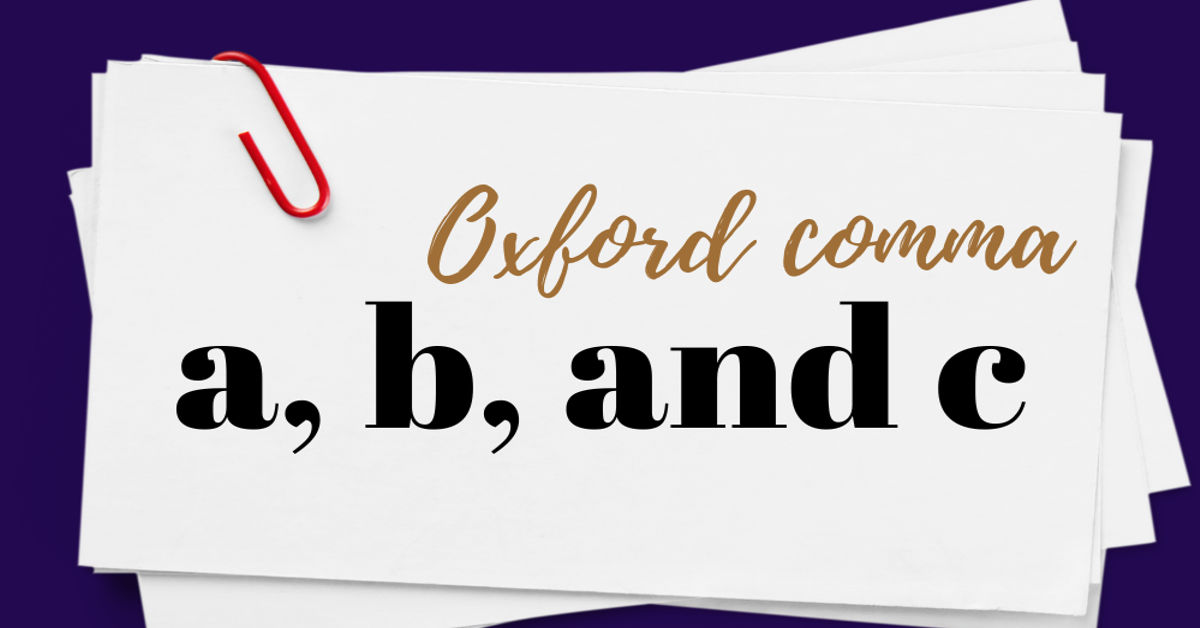In the vast world of punctuation the oxford comma might seem insignificant at first glance. But don’t be fooled. This humble comma has stirred arguments among writers, editors, teachers, and even legal professionals. Should it stay or should it go? This article unpacks the oxford comma in detail—what it is, where it came from, why people love or hate it, and how it can actually affect meaning.
What Is the Oxford Comma?
The oxford comma, also called the serial comma, is the comma placed before the final item in a list of three or more.
Example with the oxford comma:
I bought apples, bananas, and oranges.
Example without it:
I bought apples, bananas and oranges.
In both cases, the sentence is grammatically correct, but the presence or absence of that second comma can sometimes shift the meaning in subtle or even dramatic ways.
A Brief History of the Oxford Comma
The term “oxford comma” originates from Oxford University Press, where editors advocated for its use to avoid ambiguity. The punctuation mark dates back to early English printing practices, but it gained prominence in academic publishing during the 20th century.
In the U.S., it became widely accepted in formal writing, while in other parts of the world, its usage varied based on editorial preference.
Why People Use It
Supporters of the oxford comma argue that it provides clarity and consistency, particularly when a list could otherwise be confusing.
Example for clarity:
We invited the strippers, JFK, and Stalin.
Without the comma:
We invited the strippers, JFK and Stalin.
The second version implies JFK and Stalin are the strippers—an awkward misunderstanding.
Reasons people choose to use it:
- Prevents misinterpretation
- Creates a natural pause in reading
- Maintains logical separation between list items
- Aligns with some professional style guides
Why Some People Avoid It
Opponents say it’s redundant. In their view, the word “and” already does the job of separating the last two items in a list, making the comma unnecessary.
Reasons people omit it:
- Saves space, especially in journalism
- Matches AP style (commonly used in newsrooms)
- Keeps writing visually cleaner
- Rarely causes confusion in simple lists
Famous Cases and Legal Confusion
One of the most well-known examples of the oxford comma causing legal trouble occurred in 2014 with a group of dairy truck drivers in Maine. Their dispute with Oakhurst Dairy over overtime pay hinged on a sentence that lacked an oxford comma.
The court ruled in favor of the drivers due to the ambiguity, leading to a $5 million settlement. This case was a landmark moment that showcased how something as small as a comma can carry enormous weight.
Oxford Comma in Different Style Guides
| Style Guide | Oxford Comma Usage |
| APA (American Psychological Association) | Required |
| MLA (Modern Language Association) | Required |
| Chicago Manual of Style | Required |
| AP (Associated Press) | Not used |
| New York Times Manual | Rarely used |
| Oxford University Press | Required |
Writers and editors often follow style guides based on industry, purpose, or personal preference.
Pros and Cons at a Glance
| Pros of Using the Oxford Comma | Cons of Using the Oxford Comma |
| Reduces ambiguity | Can appear redundant |
| Follows academic style rules | Not required in many style guides |
| Clarifies complex lists | Takes extra space in print |
| Often improves flow of reading | May seem outdated in casual writing |
Regional Usage and Trends
The oxford comma is more common in American English than in British English. However, even within regions, practices vary widely:
- United States: Used often in academia and formal business writing
- United Kingdom: Used primarily in Oxford University Press publications
- Canada and Australia: Mixed usage depending on audience and platform
Younger generations, especially those accustomed to texting or casual writing, tend to drop it altogether unless writing formally.
Real-World Examples
With the oxford comma:
I dedicate this book to my parents, Oprah, and God.
Clear separation of three subjects.
Without it:
I dedicate this book to my parents, Oprah and God.
Suggests Oprah and God are the parents—a very different meaning.
These examples show how tone and meaning can shift dramatically based on punctuation choices.
Oxford Comma in Journalism, Law, and Literature
- Journalism: Most newsrooms follow AP style, which avoids the oxford comma to conserve space and maintain a consistent visual style.
- Legal Writing: Lawyers are generally encouraged to use the oxford comma due to its role in avoiding ambiguity.
- Literature: Many fiction and nonfiction authors use the comma based on their publishers’ style guides or personal preferences.
Authors like Stephen King and J.K. Rowling lean toward using it, while others drop it for a more modern or minimalist tone.
How to Decide Whether to Use It
Ask yourself the following:
- What style guide am I following?
- Who is my audience?
- Could a sentence be misread without it?
- Am I prioritizing clarity or conciseness?
There is no one-size-fits-all answer. The key is consistency. If you use it once, keep using it throughout the piece unless a different style guide overrides your decision.
Public Opinion and Cultural Influence
The oxford comma has found its way into pop culture. T-shirts, mugs, and memes often carry slogans like:
- “Oxford Commas Save Lives”
- “I Love My Parents, Lady Gaga, and Elvis”
The punctuation mark has developed a sort of cult following among grammar enthusiasts, while others see it as an annoying relic of the past.
Educational Impact and Grammar Instruction
English teachers often fall into two camps. Some teach the oxford comma as a best practice for clarity, while others instruct students to drop it unless a rulebook explicitly calls for it.
Standardized tests like the SAT or ACT generally favor correct usage over style preferences, meaning students should understand both perspectives.
Final Thoughts
The oxford comma may be tiny, but its influence is massive. Whether you’re writing an academic essay, drafting a contract, or penning a novel, this small punctuation mark could change how your message is received.
So should you use it? That depends on your goal, your audience, and your style guide. Just make sure to be consistent.
Still unsure?
Subscribe to our grammar newsletter, share your opinion in the comments, or try editing your own writing with and without the oxford comma to see which feels right for your voice.
Frequently Asked Questions
Is the oxford comm’a grammatically required?
No. It’s a stylistic choice, though certain style guides do require it.
Is there a legal reason to use it?
While not legally required, it can prevent misinterpretations in contracts and policies.
Who decided to name it the “oxford comma”?
It’s named after Oxford University Press, one of its earliest and strongest advocates.
Do all publishers agree on using it?
No. Publishing houses often follow different style guides.
Can I mix and match its usage in one piece of writing?
It’s not recommended. Consistency is key to professionalism in writing.











